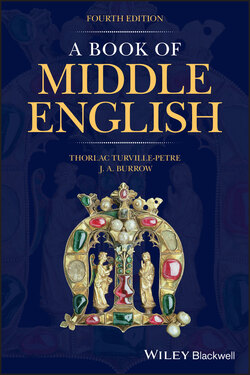Читать книгу A Book of Middle English - J. A. Burrow - Страница 91
6.4 Laʒamon’s Brut
ОглавлениеLaʒamon, writing in about 1200, used both rhyme and alliteration, sometimes as alternatives, sometimes together. He seems to have relied on two distinct models: the stress‐based alliterative line of Germanic tradition, and the rhyming couplets of Romance verse. The alliterative line was inherited from Old English, but perhaps not directly; there are examples even from before the Conquest of a much looser alliterative line with sporadic internal rhyme. On this model Laʒamon superimposed a metre learnt from Anglo‐Norman and Latin poets writing rhyming verse. In Laʒamon’s Brut the half‐lines are of varying length, predominantly of two stresses, and are linked to one another sometimes by rhyme or half‐rhyme, sometimes by alliteration, sometimes by both. With rhyme but not alliteration is:
Híʒenliche swíðe . fórð he gon líðe (3/4)
The next line has alliteration but not rhyme:
þat he bíhalves Báðe . béh to ane vélde (3/5)
Two lines further on, the word burnen both alliterates and rhymes with the second half‐line:
And ón mid heore búrnen . béornes stúrne (3/7)
In his work Laʒamon was recreating a heroic British past for an Anglo‐Norman present, and his metrical form, like other features of his style, recalls pre‐Conquest traditions. Yet his Brut does not attempt to reproduce an Anglo‐Saxon verse form, but instead develops English verse by assimilating Continental traditions.
